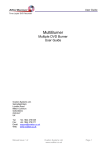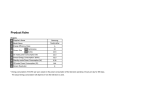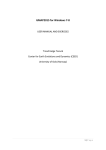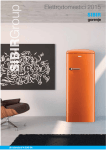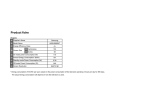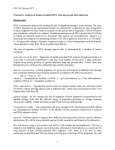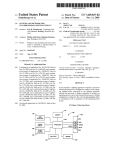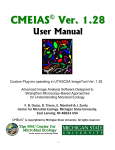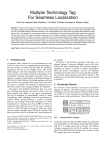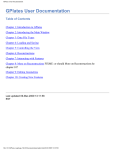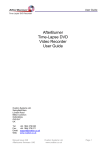Download FastRNA® Pro Soil
Transcript
FastRNA® Pro Soil-Indirect Kit One Call Rapid Isolation of Total RNA from Soil Using the FastPrep® and FastPrep® -24 Instruments Catalog # 6075-050 50 Preps One Source A World of Biotechnology Reagents Storage: Ambient temperature (15 – 30ºC) DO NOT expose Phenol:Chloroform (1:1) to light for extended periods of time. Store in the original amber bottle in the closed kit box. Revision # 6075-050-06APR www.mpbio.com MP Biomedicals • 29525 Fountain Parkway • Solon, OH 44139 • tel: 1.800.854.0530 • fax: 1.800.334.6999 FastRNA® Pro Soil-Indirect Kit FastRNA® Pro Soil-Indirect Kit Rapid Isolation of Total RNA from Soil Using the FastPrep® and FastPrep® -24 Instruments Catalog # 6075-050 50 Preps Storage: Ambient temperature (15 – 30ºC) DO NOT expose Phenol:Chloroform (1:1) to light for extended periods of time. Store in the original amber bottle in the closed kit box. Revision # 6075-050-06APR ® Soil-Indirect Kit FastRNA® Pro FastRNA Pro Soil-Indirect Kit TABLE OF CONTENTS 1. Introduction to the FastRNA® Pro Soil-Indirect Kit and the FastPrep® Instruments.............................................................................................................5 2. Kit Components and User Supplied Materials..................................................6 2.1FastRNA® Pro Soil-Indirect Kit Components............................................6 2.2 User Supplied Materials................................................................................................7 3. Important Considerations before Use.....................................................................7 3.1 Preparation of RNAMATRIX® Wash Solution.......................................7 3.2 Separation of Organic Materials from Soil..................................................8 3.3 Preparing to isolate total RNA...............................................................................8 3.4 Sample Lysis with the FastPrep® Instruments..........................................9 3.5 RNA Purity, Humic Substance and Inhibitor Removal and Downstream Applications..........................................................................................9 4. Safety Precautions....................................................................................................................10 5. Basic Protocol for All Soil Samples...........................................................................11 6. Optional Centrifugation through Quick-Clean Spin Filters...............17 7. Example Data:Total RNA Isolation and RT-PCR........................................19 8. Troubleshooting.........................................................................................................................20 8.1 Lower Than Expected or No RNA Yield.................................................20 8.2 Suspected RNA Degradation.............................................................................21 8.3 Properties of the RNA Pellet..............................................................................22 8.4 Genomic DNA Contamination.......................................................................23 8.5 RT-PCR Inhibition............................................................................................................23 8.6 Mucopolysaccharide/Carbohydrate Contamination......................24 9. Recommended Reference Format for Publication...................................25 10. References......................................................................................................................................25 11. Related Products......................................................................................................................27 11.1 FastRNA® Pro Soil-Direct Kit (Cat# 6070-050)...........................27 11.2 Other Related Products........................................................................................27 12. Product Use Limitation & Warranty........................................................................28 1. Introduction to the FastRNA® Pro Soil-Indirect Kit and the FastPrep® Instruments The FastRNA® Pro Soil-Indirect Kit quickly and efficiently isolates total cellular RNA from microorganisms and other specimens found in soil. It is designed for use with the FastPrep® and FastPrep® -24 Instruments, high-speed benchtop devices that use a unique, optimized motion to homogenize samples by multidirectional, simultaneous impaction with lysing matrix particles. FastPrep® Instruments provide an extremely quick and highly reproducible homogenization that surpasses traditional lysis methods using enzyme digestion, sonication, blending, douncing and vortexing. Soil biodiversity is directly affected by its physical and chemical composition and by environmental factors. Evidence indicates total soil biodiversity can be underestimated by approximately 90% when an in vitro culturing method is used to approximate the total number of organisms present (1, 2). For this reason, extraction of total RNA from soil has been used to detect specific genes from unculturable microorganisms, to provide a method to isolate and identify individual strains of interest, estimate soil biodiversity, estimate soil microorganism metabolic activity and to clone expressed genes (3, 4, 5, 6). Nucleic acid extraction from soil can be performed using a direct or an indirect method. The indirect method utilizes an initial separation of microorganisms and other biological specimens from the soil followed by lysis of the organisms and RNA purification (7, 8). The indirect method also permits soil incubation with growth media to amplify living organisms prior to RNA isolation if accurate measurements of microbial diversity are not required. The direct method consists of extracting nucleic acid from microorganisms and other biological specimens directly from soil (9). FastRNA® Pro Soil Kits are available from MP Biomedicals for both direct (Cat # 6070-050) and indirect (#6075-050) RNA isolation methods. FastRNA® Pro Soil-Indirect Kit Soil types differ in the type and amount of organic materials. The largest and most chemically significant fraction of natural organic matter is the humic substances, which include humic acid and fulvic acid (10). The amount and type of humic substances in a soil sample are established by a combination of environmental conditions, vegetation and topography, and will vary among soil types and even within soil at the same location. Humic substances frequently give soil a yellow/brown color and have been shown to inhibit Taq polymerase activity at concentrations as low as 0.1µg/ml (11, 12). The FastRNA® Pro Soil Kits purify RNA in a process that removes humic substances and other inhibitors, and efficiently inactivates cellular RNases during homogenization to prevent RNA degradation. The FastRNA® Pro Soil-Indirect Kit offers two levels of RNA purification that permit tailoring the protocol to the soil sample and downstream applications. In the first level, RNA is purified from contaminating soil products by selective binding to RNAMATRIX®. For the vast majority of soil types, RNAMATRIX® purification will provide RNA that is colorless and free of RT-PCR inhibitors for use in downstream applications. In the event further processing is required, a second level of purification through Quick-Clean Spin Filters will provide additional purification of colorless and contaminant-free RNA. 2. Kit Components and User Supplied Materials 2.1 FastRNA® Pro Soil-Indirect Kit Components RNApro™Solution Inhibitor Removal Solution RNAMATRIX® Slurry RNAMATRIX® Binding Solution RNAMATRIX® Wash Solution Concentrate DEPC-Treated H2O Lysing Matrix E 55 ml 12 ml 0.6 ml 35 ml 15 ml 30 ml 50 tubes Quick-Clean Spin Filters Catch Tubes User Manual MSDS Certificate of Analysis 50 filters 50 tubes 1 each 1 each 1 each 2.2 User Supplied Materials Resuspension Solution (either deionized H2O, 10 mM Tris [pH 7.0 - 8.0], or 100 mM NaCl) Cheesecloth (VWR Grade 10) RNase Erase® (See Section 11, Related Products) FastPrep® or FastPrep® 24 Instrument (See Section 11, Related Products) 100% Ethanol Chloroform Centrifuge capable of spinning at least 10 ml of liquid at less than 500 rpm (~20 x g) Centrifuge capable of spinning at least 10 ml of liquid at 5000 rpm (~1,800 x g) Microcentrifuge Chilled 70% Ethanol (prepared with DEPC-treated H2O) Chilled Isopropanol 1.5 or 2.0 ml RNase-free Microcentrifuge Tubes Agarose Gel Loading Dye Size Marker for Electrophoresis 3. Important Considerations before Use 3.1 Preparation of RNAMATRIX® Wash Solution The FastRNA® Pro Soil-Indirect Kit contains a bottle with 15 ml of RNAMATRIX® Wash Solution Concentrate. Before using this solution, add an equal volume (15 ml) of 100% ethanol and mark on the bottle label the date ethanol was added. Store at room temperature. FastRNA® Pro Soil-Indirect Kit 3.2 Separation of Organic Material from Soil The FastRNA® Pro Soil-Indirect Kit protocol incorporates incubating the soil sample with Resuspension Solution to separate microorganisms and other biological specimens from the soil using low speed centrigation prior to lysis and RNA purification. The supernatant is then filtered through cheesecloth to remove remaining soil particles (NOTE: It is important NOT to substitute sterile gauze, Kim-Wipe™ tissue or commercially available coffee filters as significant RNA yield reduction will occur.) Following filtration, microorganisms and biological specimens are concentrated from the Resuspension Solution by a second centrifugation. Pelleted organic material is then lysed in RNApro™ Solution by the FastPrep® or FastPrep® -24 Instrument. 3.3 Preparing to Isolate Total RNA The presence or introduction of RNase during the procedure may result in sample degradation. It is strongly recommended that the user minimize the potential for RNase contamination by wearing gloves throughout the procedure, using DEPC-H2O and by treating pipettmen, work area, gel box and gel comb with RNase Erase® (see section 2.2). Additional RNA handling methods and precautions are found in references 13 and 14. Confirm the Lysing Matrix E tubes spin freely and will not scrape the microcentrifuge wall during centrifugation. Add RNApro™ Solution to the sample as soon as possible to initiate RNase inhibition. FastPrep® Instrument homogenized and non-homogenized samples are stable in RNApro™ Solution for up to 24 hours at room temperature or 4ºC. It is best to process the soil sample through the complete protocol as soon as possible following collection. 3.4 Sample Lysis with the FastPrep® Instruments The fill volume in the lysing matrix tube after the addition of RNApro™ Solution to the sample should allow sufficient air space in the sample tube for efficient FastPrep® Instrument processing. Sample loss or tube failure may result from overfilling the matrix tube. The matrix tube caps must be secure, but not over-tightened, to prevent sample leakage. If the sample is too large for processing in a single tube, divide the sample and process using multiple tubes. MP Biomedicals Lysing Matrix particles and tubes have been rigorously tested and validated in the FastPrep® and FastPrep® 24 Instruments. The use of non-MP Biomedicals products with the FastPrep Instruments is not recommended and may result in sample loss or instrument failure. A single 40 second run at a speed setting of 6.0 in the FastPrep® or FastPrep®-24 Instrument is sufficient to lyse cells, organisms and tissue present within a soil sample. If the user determines that additional processing time is required, the sample should be incubated on ice in the Lysing Matrix E tube for at least 2 minutes between successive FastPrep® Instrument homogenizations to prevent sample over-heating and possible RNA degradation 3.5 RNA Purity, Humic Substance and Inhibitor Removal and Downstream Applications The FastRNA® Pro Soil-Indirect Kit selectively purifies total cellular RNA (free from DNA, protein and soil components) that is sufficiently pure for use in RT-PCR and Northern analysis. While quality control tests indicate DNA removal during RNA purification, the user may incorporate DNase I treatment of the RNA prior to use in applications where absolute control of DNA contamination is required. Use DNase I at the concentration and incubation conditions recommended by the manufacturer. DNase I is inactivated by incubation at 75ºC for 5 minutes or by addition of EDTA to 25 mM followed by phenol/chloroform extraction and precipitation (13,14). FastRNA® Pro Soil-Indirect Kit The FastRNA® Pro Soil-Indirect Kit is designed to provide two levels of RNA purification. The first level, (the basic protocol in Section 5), incorporates the proprietary RNAMATRIX® to remove soil associated reverse transcription and PCR inhibitors to allow amplification of undiluted RNA for the vast majority of soil types. It has been determined that in some instances, RNA dilution (1:3, 1:5, or 1:10) of clear or slightly colored samples may result in greater yield of PCR product. It is important to recognize that some soil samples may not RT-PCR amplify due to purification of small amounts of total or target RNA that result from a low organism content, or the soil sample may be exceptionally high in inhibiting substances, including nonspecific humic substances. If dilution of the RNA sample and nested or reamplification of the PCR reaction do not facilitate successful RT-PCR, the samples can be additionally purified using the QuickClean Spin Filters provided in the kit (Section 6). Centrifugation of purified RNA through the Quick-Clean Spin Filters as directed will remove residual inhibitors with no significant loss of RNA quantity. 4. Safety Precautions RNApro™ Solution contains components that when in contact with human tissue or during inhalation may cause irritation or burning. Wear personal protective equipment to prevent skin contact (e.g., gloves, lab coat, and eye protection), prevent inhalation of reagent vapors and consumption of liquid during use and dispose of waste following proper procedures. Consult the enclosed Material Safety Data Sheet for additional details. 10 5. Basic Protocol for All Soil Samples 1. Transfer 1 gram of soil to a 15 ml conical tube. NOTE: Greater than 1 g of soil may be used if the soil is known to contain few microorganisms or if the RNA yield is expected to be low. Also, wet soils often provide an enriched growth environment that results in greater organism diversity and RNA yield, but since a sizeable proportion of the sample weight is due to water content, more soil may be needed. Finally, numbers of viable soil microorganisms can be increased prior to RNA isolation by incubating the soil in a liquid growth media and then proceeding directly to Step 4. 2. Add 5 ml of user-supplied Resuspension Solution (either deionized H2O, 10 mM Tris [pH 7.0 – 8.0], or 100 mM NaCl). NOTE: Maintain a ratio of 1 gram soil to 5 ml Resuspension Solution. Larger soil amounts may be processed in a larger tube. 3. Mix well and incubate for 10 minutes at room temperature on a rocking device or with frequent inversion to facilitate the dissociation of organic materials from soil particles. 4. Centrifuge 5 minutes at less than 500 rpm (approximately 20 x g) at room temperature to pellet soil and large particles. NOTE: Centrifugation is intended to remove the bulk of soil components from solution while permitting microorganisms to remain in solution. Depending on soil type, a lower speed may be used. 5. Filter the supernatant through cheesecloth (VWR, Grade 10) to a new centrifuge tube capable of withstanding a force of 1,800 x g. 11 FastRNA® Pro Soil-Indirect Kit NOTE: Cheesecloth filtration is necessary in order to remove soil particles that may have carried over from the previous centrifugation. DO NOT filter through sterile gauze, KimWipe™ tissue or commercially available coffee filters as SIGNIFICANT reduction in RNA yield will occur. 6. Centrifuge at 5000 rpm (approximately 1,800 x g) for 5 minutes at room temperature to pellet microorganisms and organic material for RNA purification. 7. Decant the supernatant and add 1 ml of RNApro™ Solution to the tube. Completely resuspend the pelleted material by pipetting or vortexing. 8. Transfer 1 ml of the resuspended material to a Lysing Matrix E tube provided in the kit. Securely close the cap to prevent leakage in the next step. NOTE: The designated volumes ensure adequate airspace in the matrix tube to prevent sample leakage and/or tube failure. DO NOT overfill the matrix tube. Use a second matrix tube to process a larger sample. 9. Process the sample in the FastPrep® or FastPrep®-24 Instrument for 40 seconds at a setting of 6.0. 10. Remove the tube and centrifuge at ≥ 14,000 x g for 5 minutes at room temperature. 11. Transfer the liquid to a microcentrifuge tube. NOTE: Minimal debris carryover will not affect subsequent steps. 12. Incubate the sample 5 minutes at room temperature to increase RNA yield. 13. Add 300 µl of user-supplied chloroform (NO isoamyl alcohol) and vortex 10 seconds. 12 14. Incubate 5 minutes at room temperature to permit nucleoprotein dissociation and increase RNA purity. 15. Centrifuge at ≥ 14,000 x g for 5 minutes at 4º C. 16. Remove the upper aqueous phase to a new microcentrifuge tube without disturbing the interphase. NOTE: If a portion of the interphase is accidentally transferred, repeat the centrifugation in step 15 with the contaminated upper phase and transfer the new upper phase to a clean microcentrifuge tube. 17. Add 200 µl of Inhibitor Removal Solution. Invert 5 times to completely mix. 18. Centrifuge at ≥ 14,000 x g for 5 minutes at room temperature. 19. Remove the liquid above the pellet to a new microcentrifuge tube. NOTE: Following centrifugation, a 10 – 25 µl “bubble” may appear over a debris pellet. If a bubble appears, transfer only the liquid above the bubble to a new RNase-free microcentrifuge tube. 20. Add 660 µl of cold 100% isopropanol to the sample, invert 5 times to mix and place at -20ºC for at least 30 minutes. NOTE: White strands may be observed in some samples. The strands, which include DNA and humic substances, will be removed in subsequent steps. 21. Centrifuge at ≥ 14,000 x g for 15 minutes at 4º C and discard the supernatant. NOTE: The RNA pellet may appear as chocolate-colored or “dirty” due to the presence of humic substances 13 FastRNA® Pro Soil-Indirect Kit contamination. The amount of color and contamination will vary between soil samples and will be removed in subsequent steps. 22. Carefully wash the pellet with 500 µl of cold 70% ethanol (made with DEPC-H2O). 23. Remove the ethanol and air dry the pellet 5 minutes at room temperature. NOTE: DO NOT completely dry the RNA as this will increase the difficulty of resuspending the RNA in the next step. 24. Resuspend the RNA in 200 µl of DEPC-H2O. 25. Add 600 µl of RNAMATRIX® Binding Solution and 10 µl of RNAMATRIX® Slurry to the RNA. Incubate at room temperature on a shaker table, a rotator, or with frequent inversion for 5 minutes. 26. Microcentrifuge (pulse-spin) approximately 10 seconds to pellet the RNAMATRIX®-bound RNA and discard the supernatant. Use caution not to remove the RNAMATRIX®. 27. Completely resuspend the RNAMATRIX®-bound RNA in 500 µl of prepared RNAMATRIX® Wash Solution. NOTE: Ensure that 15 ml of ethanol has been added to the RNAMATRIX® Wash Solution Concentrate prior to use. 28. Microcentrifuge (pulse-spin) approximately 10 seconds and discard the supernatant. Use caution not to remove the RNAMATRIX®. 29. Microcentrifuge (pulse-spin) a second time for approximately 10 seconds and carefully remove any residual wash solution with a pipet. Use caution not to remove the RNAMATRIX®. 14 30. Air dry 5 minutes at room temperature. 31. Add 50 µl of DEPC-H2O and completely resuspend the RNAMATRIX® by vortexing. Incubate 5 minutes at room temperature to elute the RNA. Finger tap the tube bottom frequently to provide gentle mixing. 32. Microcentrifuge (pulse-spin) approximately 10 seconds and transfer the supernatant containing eluted RNA to a new tube. NOTE: Do not discard the RNAMATRIX® pellet! 33. Repeat step 31 and 32 to provide a final RNA volume of 100 µl. NOTE: If matrix carryover occurs, remove the matrix by pulse-centrifuging the microcentrifuge tube for approximately 10 seconds to pellet the matrix. Carefully transfer only the supernatant to a new RNase-free microcentrifuge tube. 34. Determine the RNA concentration and integrity: a. Dilute 5 µl of the purified RNA into 495 µl of DEPC- H2O b. Read the OD260 using DEPC-H2O as a blank c. Calculate the sample µg RNA per ml using the formula: (OD260)(40 µg/ml/per OD)(100 [dilution factor]) = µg RNA per ml Spectrophotometer accuracy is greatest between ~ 0.2 and ~ 0.8. If the OD reading is below this range, add more RNA sample (e.g., 20 µl RNA + 480 µl DEPC-H2O) or concentrate the RNA by precipitation and resuspension into a smaller volume. If the OD reading is above the recommended spectrophotometer range, use less RNA for the OD determination. If RNA yield is low, greater accuracy will be achieved by concentrating the RNA sample before analysis or use agarose gel electrophoresis to approximate the concentration. 15 FastRNA® Pro Soil-Indirect Kit RNA integrity and an estimation of yield can be determined by analyzing a portion of the RNA sample using gel electrophoresis and comparing it to a known amount of RNA.Take a 15 µl aliquot of RNA, add gel loading buffer and load the sample and the known amount of RNA on a 1.0% agarose gel at ~ 100 volts for 30 minutes. Ethidium bromide may be added to the denatured RNA sample at 10 µg per milliliter prior to gel loading or the gel may be ethidium bromide stained and destained following electrophoresis and visualized under UV light. The quality of the RNA is determined by the appearance of distinct large and small ribosomal RNAs of approximately 0.9 to 1.5 kb. Due to the potential organism heterogeneity in a soil sample multiple bands may be present. The purified rRNA concentration may appear low, but is not completely indicative of the amount of mRNA present in the sample. RT-PCR will often yield positive results in the absence of visible rRNA. 35. Evaluate the purified RNA for use in RT-PCR. If the purified RNA appears colorless it is acceptable for use in Northern analysis and should perform satisfactorily in RTPCR. For RT-PCR amplification, it is recommended to test 1 µl undiluted and 1 µl of RNA diluted 1:3, 1:5 and 1:10. If the RNA does not amplify satisfactorily, continue with additional purification using Quick-Clean Spin Filters to remove residual inhibiting substances (Section 6). 36. Aliquot and store the RNA at -70ºC. 16 NOTE: RNA is generally stable for up to a year at -70 to 80ºC. For longer-term storage, RNA samples may be stored as ethanol precipitates.When stored as an ethanol precipitate, the RNA must be spun down, washed and resuspended in aqueous solution prior to use. Avoid frequent sample freezethaw by storing isolated RNA as aliquots. NOTE: RNA does not evenly distribute in ethanol and can lead to inconsistent RNA amounts between samples when equal volumes are pipetted. Vortex the RNA:ethanol solution to disperse the RNA prior to removing the sample. In situations where precise amounts of RNA are required it is best to precipitate the total amount (or excess) of RNA required, resuspend the RNA in DEPC-H2O and measure the concentration by OD260 before proceeding. NOTE: RNA is generally stable for up to a year at -70 to -80º C. For longer-term storage, RNA samples may be stored as ethanol precipitates. When stored as an ethanol precipitate, the RNA must be spun down, washed and resuspended in aqueous solution prior to use. Avoid frequent sample freezethaw by storing isolated RNA as aliquots. NOTE: RNA does not evenly distribute in ethanol and can lead to inconsistent RNA amounts between samples when equal volumes are pipetted. Vortex the RNA:ethanol solution to disperse the RNA prior to removing the sample. In situations where precise amounts of RNA are required it is best to precipitate the total amount (or excess) of RNA required, resuspend the RNA in DEPC-H2O and measure the concentration by OD260 before proceeding. 6. Optional Centrifugation Through Quick-Clean Spin Filters The FastRNA® Pro Soil-Indirect Kit is designed to remove reverse transcription and PCR inhibitors to allow amplification of undiluted RNA for the vast majority of soil types. It has been determined that in some instances, RNA dilution (1:3, 1:5, or 1:10) may result in greater yield of PCR product. It is important to recognize that some soil samples may not RT-PCR amplify due to purification of small amounts of total or target RNA that result from a low organism content, or the soil sample may be exceptionally high in inhibiting substances, including nonspecific humic substances. If dilution of the RNA sample and nested or reamplification of the PCR reaction do not facilitate successful RT-PCR, the samples can be additionally purified using the Quick17 FastRNA® Pro Soil-Indirect Kit Clean Spin Filters. Centrifugation of purified RNA through the Quick-Clean Spin Filter as directed will remove residual inhibitors with no significant loss of RNA quantity. 1. If the RNA sample is frozen, thaw completely and centrifuge briefly to bring the liquid to the tube bottom before proceeding. 2. Applying 50 µl DEPC-H2O to the Quick-Clean Spin Filter, insert the filter into a user-supplied RNase-free microcentrifuge tube and pulse spin for 10 seconds. 3. Transfer the Quick-Clean Spin Filter to a new, kit supplied RNase-free Catch Tube, insert into the microcentrifuge rotor, and apply the RNA (up to 300 µl may be processed) to the Quick-Clean Spin Filter. NOTE: Do not leave the RNA in contact with the QuickClean Spin Filter for more than 60 seconds before pulse spinning for 10 seconds in the next step or RNA loss will occur. 4. Pulse-spin the Quick-Clean Spin Filter and Catch Tube for 10 seconds to collect purified RNA. 5. Quantify the RNA per Step 34 in section 5. 18 7. Example Data: Total RNA Isolation and RT-PCR 1 2 3 4 5 PICTURE 1 : FastRNA Pro Soil Indirect Kit Total RNA extracted from Soil Samples with the FastRNA® Pro SoilIndirect Kit. Approximately 15% of the total RNA isolated from four different soil samples was loaded on to a 0.8% agarose gel. Lane 1: 1kb ladder, Lane 2: RNA from 5 g Soil #1, Lane 3: RNA from 10 g Soil #2, Lane 4: RNA from 5 g Soil #7, Lane 5: RNA from 5 g Soil #10. 19 FastRNA® Pro Soil-Indirect Kit 1 2 3 4 5 PICTURE 2 : FastRNA Pro Soil Indirect Kit RT-PCR of Fungal Gene from Total RNA Isolated from Soil Samples with the FastRNA® Pro Soil-Indirect Kit. Approximately 40% of the RT-PCR reaction was loaded on to a 0.8% agarose gel. Lane 1: 150bp – 2kb marker, Lane 2: Soil #1, Lane 3: Soil #2, Lane 4: Soil #7, Lane 5: Soil #10. 8.Troubleshooting 8.1 Lower Than Expected or No RNA Yield Due to natural soil diversity soil samples may contain very low amounts of the desired organism(s) for extracting RNA. Additional numbers of the same sample may be processed using multiple tubes and the purified RNA pooled. Alternatively, a greater amount of soil can be used in step 1 of the protocol in section 5. 20 Soil samples stored for extended periods may result in organism and RNA deterioration. To prevent sample deterioration, process the sample immediately following collection. In order to understand storage deterioration in specific soil types a control stability experiment using a laboratory microorganism (i.e., E. coli or S. cereviseae) stored in the soil sample may be performed. Add equivalent amounts of microorganism to aliquots of the soil and store using the standard method. Prepare RNA from the stability samples over extended time periods (e.g., hours, days, weeks) to provide information about the relative RNA yields and losses that can be expected during storage. Aliquots of the control microorganism may also be stored without soil and processed in parallel to compare RNA yield with the soil stability samples Lack of RNA degradation in the non-soil control tube indicates the soil stability sample RNA was likely degraded during soil storage prior to the addition of RNApro™ Solution. Certain bacterial strains may contain elevated RNase levels. Reduce the exposure time to RNase by adding the RNApro™ Solution to each sample as soon as possible following sample harvest. RNApro™ Solution will protect RNA in soil samples from degradation for at least 24 hours at room temperature or 40C. 8.2 Suspected RNA Degradation The quality of RNA can be determined after electrophoresis by the appearance of distinct large and small ribosomal RNAs (rRNA) of approximately 0.9 to 1.5 kb. Due to the potential organism heterogeneity in a soil sample multiple bands may be present. The purified rRNA concentration may appear low, but is not completely indicative of the amount of mRNA present in the sample. RT-PCR will often yield positive results in the absence of visible rRNA. Messenger RNA (mRNA),which typically represents approximately 1% of the total cellular RNA and is heterogeneous length, may not be highly visible. Ribosomal RNA is used as a marker to assess sample degradation. Degraded RNA or mRNA may appear as 21 FastRNA® Pro Soil-Indirect Kit unequal fluorescent intensity between bands, a single rRNA band may be completely lacking or a heterogeneous fluorescent smear may appear below the rRNA bands. The rRNA content is not an accurate indication of mRNA content purified from soil. Samples that lack visible rRNA in agarose gel electrophoresis will often function successfully in RT-PCR amplification. RNase may have been introduced during isolation. To prevent RNAse contamination, the use of gloves, RNase-free plugged pipette tips and RNase free tubes is strongly recommended. Clean pipetmen and work area with RNase Erase® (Catalog # 2440-204) prior to beginning RNA isolation. Use DEPC-treated reagents. RNApro™ Solution contains RNase inactivating components and will not support RNase contamination. Ensure that DEPC-treated H2O was used to make the 70% ethanol. Artifactual RNA degradation may occasionally occur during gel electrophoresis due to a gel that was not RNase free, running the gel at too high voltage or from using depleted running buffer. Rerun the samples with a known intact RNA sample using freshly prepared RNase-free electrophoresis reagents. 8.3 Properties of the RNA Pellet Following RNA precipitation the purified RNA may not appear as a pellet at the tube bottom but may instead adhere to the side of the tube. The RNA may not be visible in the pellet or on the tube side and it may appear that RNA has not been purified. Complete the protocol and confirm the RNA concentration by OD260 and integrity by gel electrophoresis. RNA adhering to the tube wall will not affect its purity, size or use in subsequent applications. Following RNA precipitation the RNA pellet may not be firmly attached to the side or bottom of the tube and may be observed floating in the solution or at the solution surface. Re-centrifuge the sample in the same tube and exercise caution to not lose the pellet when removing the supernatant. 22 A brown color present in the RNA pellet after Step 21 is most likely due to co-purification of humic substances which will be removed by the RNAMATRIX® in steps 25-33. It has been determined that in some instances, RNA dilution (1:3, 1:5, or 1:10) may result in greater yield of PCR product. It is important to recognize that some soil samples may not RT-PCR amplify due to purification of small amounts of total or target RNA that result from a low organism content, or the soil sample may be exceptionally high in inhibiting substances, including nonspecific humic substances. If dilution of the RNA sample and nested or reamplification of the PCR reaction do not facilitate successful RT-PCR, it is recommended the samples receive additional purification using the kit provided Quick-Clean Spin Filters. 8.4 Genomic DNA Contamination The FastRNA® Pro Soil-Indirect Kit is designed to remove genomic DNA during sample processing. However, if genomic DNA contamination is suspected, it will appear as a high molecular weight smear on a denaturing gel. Genomic DNA contamination and/or protein contamination may appear during agarose electrophoresis as ethidium bromide stained material in the gel loading well. To remove the DNA and/or protein, reextract the RNA sample with phenol (pH 5.2, saturated with 0.1 M Tris):chloroform or chloroform:isoamyl alcohol (24:1, v:v). The lower phase of the extraction contains the genomic DNA; protein will accumulate at the organic:aqueous interface. Both the lower phase and the interphase protein should be carefully avoided when removing the top aqueous RNA-containing phase. Leaving a small volume of the top phase in the tube will help prevent accidental DNA or protein contamination. 8.5 RT-PCR Inhibition The FastRNA® Pro Soil-Indirect Kit is designed to provide levels of RNA purification that permit tailoring the protocol to the soil sample and the amount of reverse transcription and PCR inhibitors present in the soil sample. Steps 1 – 33 provide the first level of purification using proprietary RNAMATRIX®. Section 6 23 FastRNA® Pro Soil-Indirect Kit provides second level purification through Quick-Clean Spin Filters. RNAMATRIX® purification provides sufficient RNA purification for the majority of soil samples that permits RNA use in Northern analysis and RT-PCR amplification without additional purification. It has been demonstrated that in some instances, RNA dilution prior to amplification (1:3, 1:5, or 1:10) may result in greater yield of PCR product. It is important to recognize that individual soil samples that are resistant to RT-PCR may have a low amount of RNA due to low organism content or may be so high in inhibiting substances, including nonspecific humic acids, that dilution of the RNA sample still does not allow successful RT-PCR. For these samples, MP Biomedicals has included QuickClean Spin Filters in the FastRNA® Pro Soil-Indirect Kit as an optional last step. Centrifugation of purified RNA through the Quick-Clean Spin Filter as directed will remove any residual enzymatic inhibitors with no significant loss of RNA quantity. Unsuccessful RT-PCR may also result from the inadvertent introduction of RNase into RT-PCR reagents during experimental handling. Include a control RNA with the RT-PCR reagents to test for RNA degradation. Unsuccessful RT-PCR may result if the reverse transcriptase and/ or the thermostable polymerase is inactive or was not added to the reaction, or if other solutions are compromised or omitted. Perform RT-PCR using enzymes and buffers with a known control RNA and primers. Unsuccessful RT-PCR may also result if PCR primer conditions have not been optimized. Test the amplification primers using a control RNA to confirm the ideal annealing temperature and concentration. 8.6 Mucopolysaccharide / Carbohydrate Contamination Cellular mucopolysaccharides will not co-purify with RNA using the protocol and reagents in the FastRNA® Pro Soil-Indirect Kit. 24 9. Recommended Reference Format for Publication Total RNA was isolated from _____ g of (type) soil using the FastRNA® Pro Soil-Indirect Kit (MP Biomedicals, Irvine CA) and FastPrep®-24 Instrument (MP Biomedicals, Irvine CA). Samples have been homogenized for _____ seconds at a speed setting of _____. 10. References 1. Faegri, A.,V. L.Torsvik, and J. Goksöyr. 1977. Bacterial and fungal activities in soil: separation of bacteria and fungi by a rapid fractionated centrifugation technique. Soil Biol. Biochem. 9:105-112. 2. Roszak, D. B., and R. R. Colwell. 1987. Survival strategies of bacteria in the natural environment. Microbiol. Rev. 51: 365379. 3. Selenska, S., and W. Klingmüller. 1991. DNA recovery and molecular analysis of DNA and RNA from soil. Microb. Releases 1: 41-46. 4. Bej, A. K., M. Perlin, and R. M. Atlas. 1991. Effect of introducing genetically engineered microorganisms on soil microbial community diversity. FEMS Microbiol. Ecol. 86: 169-175. 5. Ka, J.O., Z . Yu, and W.W. Mohn. 2001. Monitoring the Size and Metabolic Activity of the Bacterial Community during Biostimulation of Fuel-Contaminated Soil using Competitive PCR and RT-PCR. Microb. Ecol. 42:267-273. 6. Hurt R.A., X. Qiu, L. Wu,Y. Roh, A.V. Palumbo, J.M.Tiedje, and J. Zhou. 2001. Simultaneous recovery of RNA and DNA from soils and sediments. Appl. Environ. Microbiol. 67:4495-503. 25 FastRNA® Pro Soil-Indirect Kit 7. Ogram, A., G. S. Sayler, and T. Barkay. 1987. The extraction and purification of microbial DNA from sediments. J. Microb. Methods. 7:57-66. 8. Torsvik, V. L. 1980. Isolation of bacterial DNA from soil. Soil Biol. Biochem. 12:15-21. 9. Holben, W. E., J. K. Jansson, B. K. Chelm, and J. M. Tiedje. 1988. DNA probe method for the detection of specific microorganisms in the soil bacterial community. Appl. Environ. Microbiol. 54:703-711. 10. Humus Chemistry, Stevenson F.J. John Wiley & sons, Inc. 2nd Edition, 1994. 11. Tebbe, C. C., and Wilfried Vahjen. 1993. Interference of Humic Acids and DNA Extracted Directly from Soil in Detection and Transformation of Recombinant DNA from Bacteria and Yeast. Appl. Environ. Microbiol. 59: 2657-2665. 12. Tsai, Y.-L., and B. H. Olson. 1992. Detection of low numbers of bacterial cells in soils and sediments by polymerase chain reaction. Appl. Environ. Microbiol. 58:754-757. 13. Molecular Cloning, Sambrook and Russell. Cold Spring Harbor Laboratory Press, 3rd Edition, 2001. 14. Current Protocols in Molecular Biology, John Wiley & Sons, Inc., 2002, www.currentprotocols.com. 26 11. Related Products 11.1 FastRNA® Pro Soil-Direct Kit (Cat# 6070-050) The FastRNA® Pro Soil-Direct Kit is designed to efficiently isolate total RNA from organic material found in soil samples. Cellular material is washed away from soil particles, centrifuged, and homogenized by the FastPrep® or FastPrep® 24 Instrument in impact-resistant 2 ml tubes containing Lysing Matrix E. Total RNA is released into a protective solution, extracted, precipitated, and purified from inhibiting substances with the proprietary RNAMATRIX® and optional Quick-Clean Spin Filter. Total RNA prepared with this kit is suitable for RT-PCR and other applications. 11.2 Other Related Products Description FastPrep® -24 Instrument FastPrep® FP100A Instrument FastPrep® FP120A Instrument FastPrep® FP220A Instrument FastRNA® Pro Soil-Direct Kit FastRNA® Pro Red Kit (Yeast) FastRNA® Pro Green Kit (Plant & Animal) FastRNA® Pro Blue Kit (Bacteria) FastDNA® Kit FastDNA® SPIN Kit FastDNA® SPIN Kit for Soil FastProtein™ Blue Matrix FastProtein™ Red Matrix RNase Erase® Size 100-230V 100V 120V 220V 50 preps 50 preps Catalog # 6002-500 6001-100 6001-120 6001-220 6070-050 6035-050 50 preps 50 preps 100 preps 100 preps 50 preps 50 preps 50 preps 500 ml 6045-050 6025-050 6540-400 6540-600 6560-200 6550-400 6550-600 2440-204 27 FastRNA® Pro Soil-Indirect Kit 12. Product Use Limitation & Warranty The products presented in this instruction manual are for research or manufacturing use only. They are not to be used as drugs or medical devices in order to diagnose, cure, mitigate, treat or prevent diseases in humans or animals, either as part of an accepted course of therapy or in experimental clinical investigation. These products are not to be used as food, food additives or general household items. Purchase of MP Biomedicals products does not grant rights to reproduce, modify, or repackage the products or any derivative thereof to third parties. MP Biomedicals makes no warranty of any kind, expressed or implied, including merchantability or fitness for any particular purpose, except that the products sold will meet our specifications at the time of delivery. Buyer’s exclusive remedy and the sole liability of MP Biomedicals hereunder shall be limited to, at our discretion, no replacement or compensation, product credits, refund of the purchase price of, or the replacement of materials that do not meet our specification. By acceptance of the product, Buyer indemnifies and holds MP Biomedicals harmless against, and assumes all liability for, the consequence of its use or misuse by the Buyer, its employees or others, including, but not limited to, the cost of handling. Said refund or replacement is conditioned on Buyer notifying MP Biomedicals. within thirty (30) days of receipt of product. Failure of Buyer to give said notice within thirty (30) days shall constitute a waiver by the Buyer of all claims hereunder with respect to said material(s). FastRNA®, FastDNA®, FastPrep® and BIO 101® Systems are registered trademarks of MP Biomedicals, LLC. RNApro™ is a trademark of MP Biomedicals, LLC. 28 Worldwide Ordering and Technical Support United States of America Worldwide Headquarters Tel: +1.440.337.1200 Toll Free Tel: 800.854.0530 Fax: +1.440.337.1180 Toll Free Fax: 800.334.6999 Germany MP Biomedicals Gmbh Phone: 0800 426 67337 Fax: 0800 629 67337 Serbia and Montenegro MP Global d.o.o. Tel: +381.11.2622.945 Fax: +381.11.2623.373 Italy MP Biomedicals Italy Tel: 0800 011 643 Fax: 0800 255 220 Singapore MP Biomedicals Asia Pacific Pte Ltd Tel: 65.6775.0008 Fax: 65.6775.4536 Australia MP Biomedicals Australasia Pty Ltd Tel: +61.2.9838.7422 Fax: +61.2.9838.7390 Japan MP Bio Japan K.K. Tel: 03-3808-2102 Toll Free Tel: 0120.788.020 Fax: 03-3808-2401 Switzerland MP Biomedicals Switzerland Tel: 061 271 0007 Fax: 061 271 0084 Belgium MP Biomedicals Europe n.v./s.a. Tel: 02 466 00 00 Fax: 02 466 26 42 United Arab Emirates The Netherlands MP Biomedicals FZ-LLC MP Biomedicals Netherlands Tel: +971.4.367.6544 Tel: 0800-0227416 Fax: +971.4.368.8031 Fax: 0800-0227489 Canada MP Biomedicals Canada Tel: 888.362.5487 Fax: 514.935.7541 Poland MP Biomedicals Poland Tel: +48.22.659.58.95 Fax: +48.22.658.45.05 France MP Biomedicals France Tel: 03 88 67 54 25 Fax: 03 88 67 19 45 Russia MP Biomedicals Russia Tel: +7 095.995.2844 Fax: +7 095.995.2846 Europe Toll Free Phone: 00800.7777.9999 Toll Free Fax: 00800.6666.8888 United Kingdom MP Biomedicals UK Tel: 0800 282 474 Fax: 0800 614 735 www.mpbio.com MP Biomedicals • 29525 Fountain Parkway • Solon, OH 44139 • tel: 1.800.854.0530 • fax: 1.800.334.6999
































